Research Analysis: Smart Contracts Adoption and Implementation Issues
VerifiedAdded on 2021/11/13
|8
|1205
|48
Report
AI Summary
This report presents a research analysis of the issues surrounding the adoption and implementation of smart contracts, primarily based on blockchain technology. The study employs a systematic mapping technique to examine the technical aspects of smart contracts, with the objective of understanding how other scholars have approached this research area. The analysis identifies key issues, including codifying security performance problems, privacy concerns, and performance limitations due to sequential execution. The research also highlights the relevance of smart contracts in various applications such as education, development, and investment, and provides a preliminary literature review of the topic. The methodology involves data extraction from scholarly materials, focusing on keywords related to smart contracts, using databases like IEEE Explore and Scopus. The report discusses lessons learned from the literature review and outlines a theoretical framework based on a systematic mapping approach to ensure comprehensive data collection. The research design involves a three-week analysis of 20 scholarly materials, emphasizing the impact of smart contract issues on blockchain technology utilization.
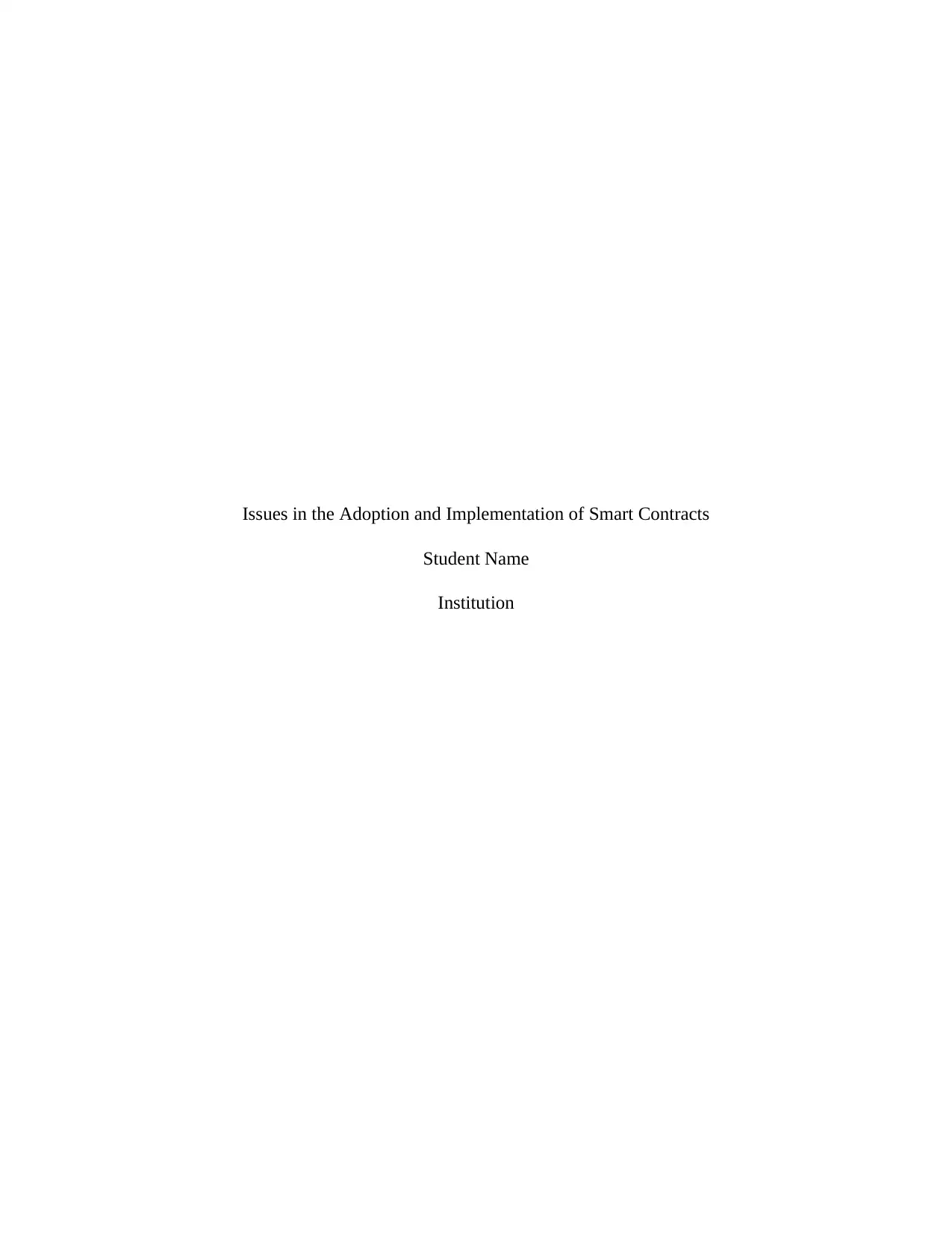
Issues in the Adoption and Implementation of Smart Contracts
Student Name
Institution
Student Name
Institution
Paraphrase This Document
Need a fresh take? Get an instant paraphrase of this document with our AI Paraphraser
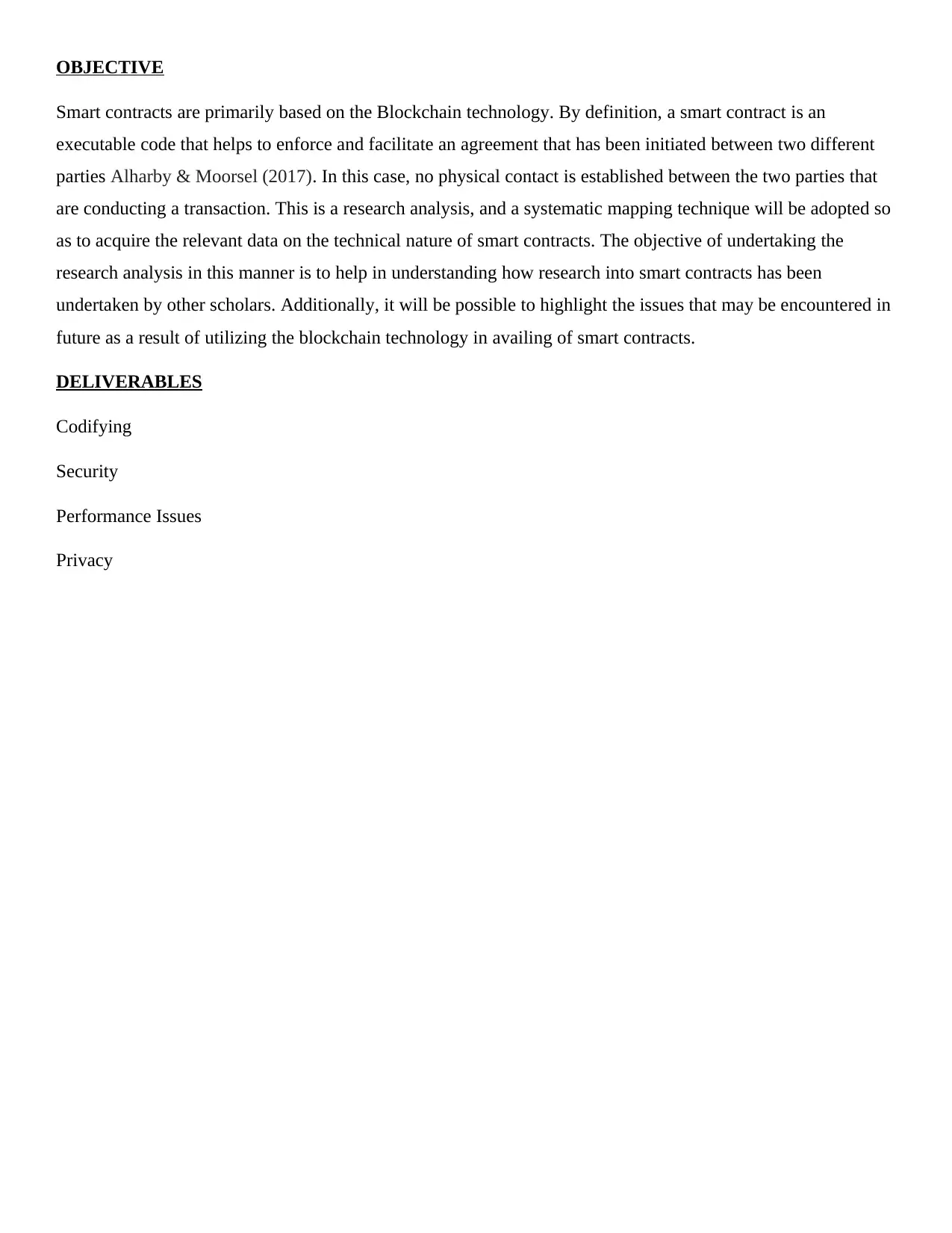
OBJECTIVE
Smart contracts are primarily based on the Blockchain technology. By definition, a smart contract is an
executable code that helps to enforce and facilitate an agreement that has been initiated between two different
parties Alharby & Moorsel (2017). In this case, no physical contact is established between the two parties that
are conducting a transaction. This is a research analysis, and a systematic mapping technique will be adopted so
as to acquire the relevant data on the technical nature of smart contracts. The objective of undertaking the
research analysis in this manner is to help in understanding how research into smart contracts has been
undertaken by other scholars. Additionally, it will be possible to highlight the issues that may be encountered in
future as a result of utilizing the blockchain technology in availing of smart contracts.
DELIVERABLES
Codifying
Security
Performance Issues
Privacy
Smart contracts are primarily based on the Blockchain technology. By definition, a smart contract is an
executable code that helps to enforce and facilitate an agreement that has been initiated between two different
parties Alharby & Moorsel (2017). In this case, no physical contact is established between the two parties that
are conducting a transaction. This is a research analysis, and a systematic mapping technique will be adopted so
as to acquire the relevant data on the technical nature of smart contracts. The objective of undertaking the
research analysis in this manner is to help in understanding how research into smart contracts has been
undertaken by other scholars. Additionally, it will be possible to highlight the issues that may be encountered in
future as a result of utilizing the blockchain technology in availing of smart contracts.
DELIVERABLES
Codifying
Security
Performance Issues
Privacy
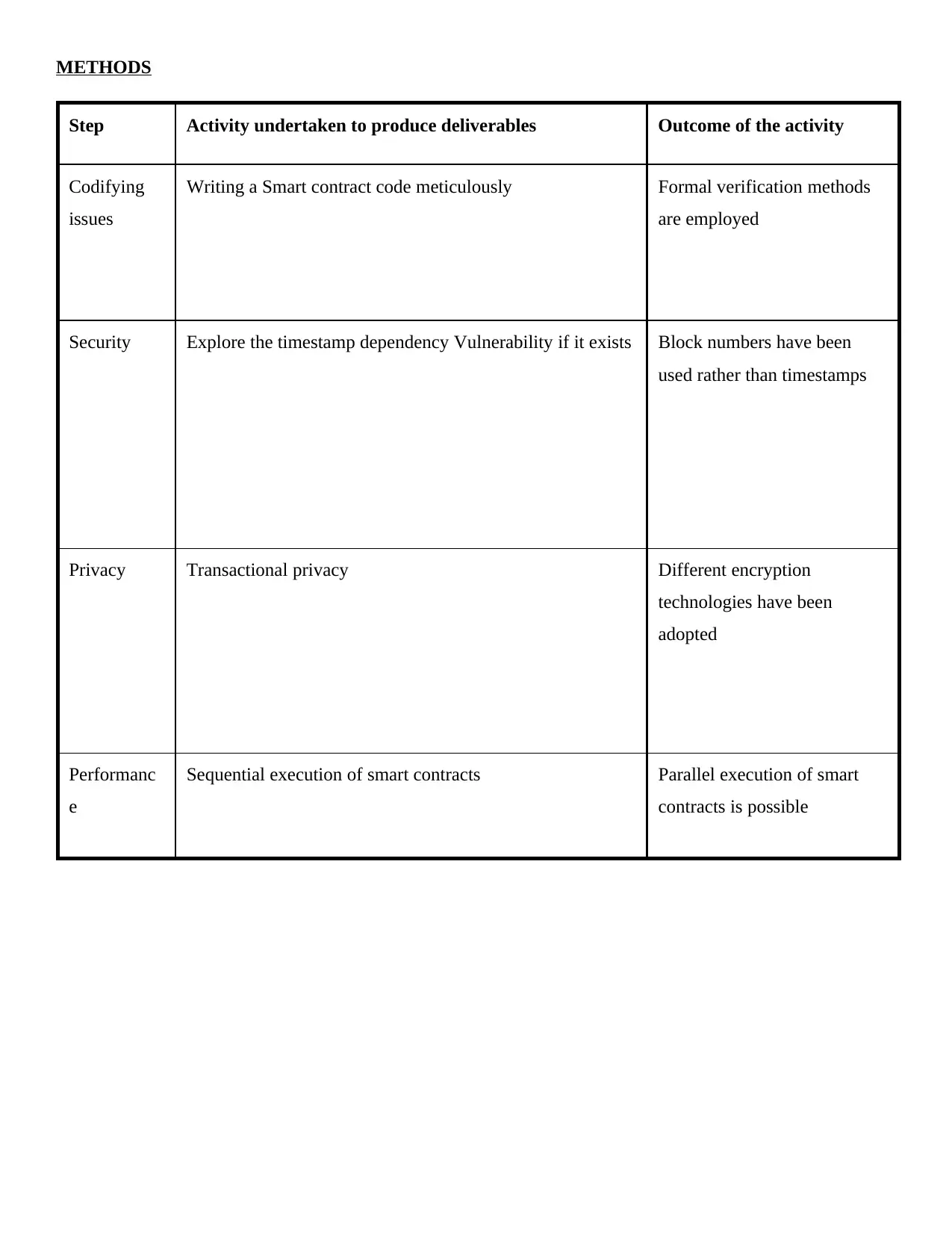
METHODS
Step Activity undertaken to produce deliverables Outcome of the activity
Codifying
issues
Writing a Smart contract code meticulously Formal verification methods
are employed
Security Explore the timestamp dependency Vulnerability if it exists Block numbers have been
used rather than timestamps
Privacy Transactional privacy Different encryption
technologies have been
adopted
Performanc
e
Sequential execution of smart contracts Parallel execution of smart
contracts is possible
Step Activity undertaken to produce deliverables Outcome of the activity
Codifying
issues
Writing a Smart contract code meticulously Formal verification methods
are employed
Security Explore the timestamp dependency Vulnerability if it exists Block numbers have been
used rather than timestamps
Privacy Transactional privacy Different encryption
technologies have been
adopted
Performanc
e
Sequential execution of smart contracts Parallel execution of smart
contracts is possible
⊘ This is a preview!⊘
Do you want full access?
Subscribe today to unlock all pages.

Trusted by 1+ million students worldwide
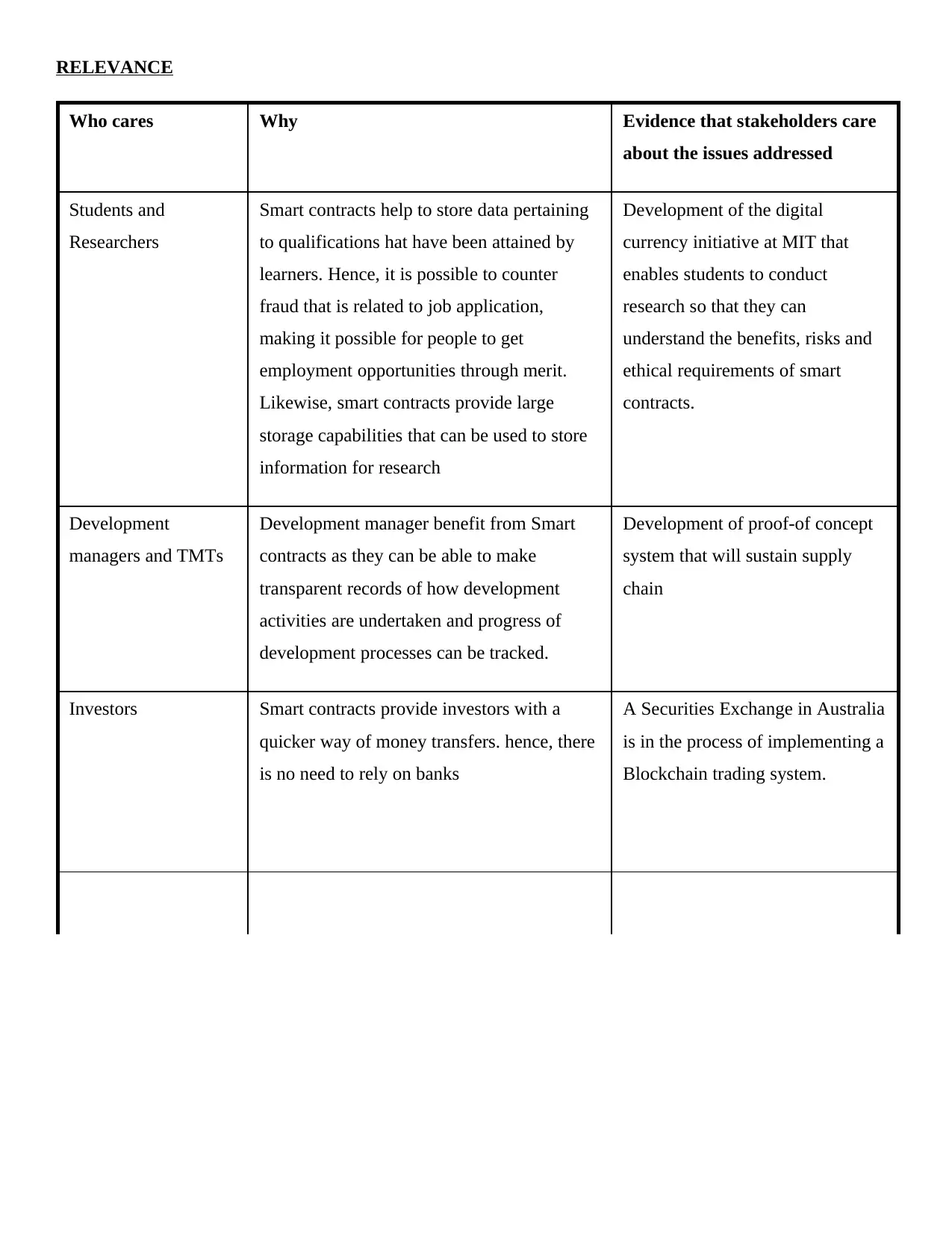
RELEVANCE
Who cares Why Evidence that stakeholders care
about the issues addressed
Students and
Researchers
Smart contracts help to store data pertaining
to qualifications hat have been attained by
learners. Hence, it is possible to counter
fraud that is related to job application,
making it possible for people to get
employment opportunities through merit.
Likewise, smart contracts provide large
storage capabilities that can be used to store
information for research
Development of the digital
currency initiative at MIT that
enables students to conduct
research so that they can
understand the benefits, risks and
ethical requirements of smart
contracts.
Development
managers and TMTs
Development manager benefit from Smart
contracts as they can be able to make
transparent records of how development
activities are undertaken and progress of
development processes can be tracked.
Development of proof-of concept
system that will sustain supply
chain
Investors Smart contracts provide investors with a
quicker way of money transfers. hence, there
is no need to rely on banks
A Securities Exchange in Australia
is in the process of implementing a
Blockchain trading system.
Who cares Why Evidence that stakeholders care
about the issues addressed
Students and
Researchers
Smart contracts help to store data pertaining
to qualifications hat have been attained by
learners. Hence, it is possible to counter
fraud that is related to job application,
making it possible for people to get
employment opportunities through merit.
Likewise, smart contracts provide large
storage capabilities that can be used to store
information for research
Development of the digital
currency initiative at MIT that
enables students to conduct
research so that they can
understand the benefits, risks and
ethical requirements of smart
contracts.
Development
managers and TMTs
Development manager benefit from Smart
contracts as they can be able to make
transparent records of how development
activities are undertaken and progress of
development processes can be tracked.
Development of proof-of concept
system that will sustain supply
chain
Investors Smart contracts provide investors with a
quicker way of money transfers. hence, there
is no need to rely on banks
A Securities Exchange in Australia
is in the process of implementing a
Blockchain trading system.
Paraphrase This Document
Need a fresh take? Get an instant paraphrase of this document with our AI Paraphraser
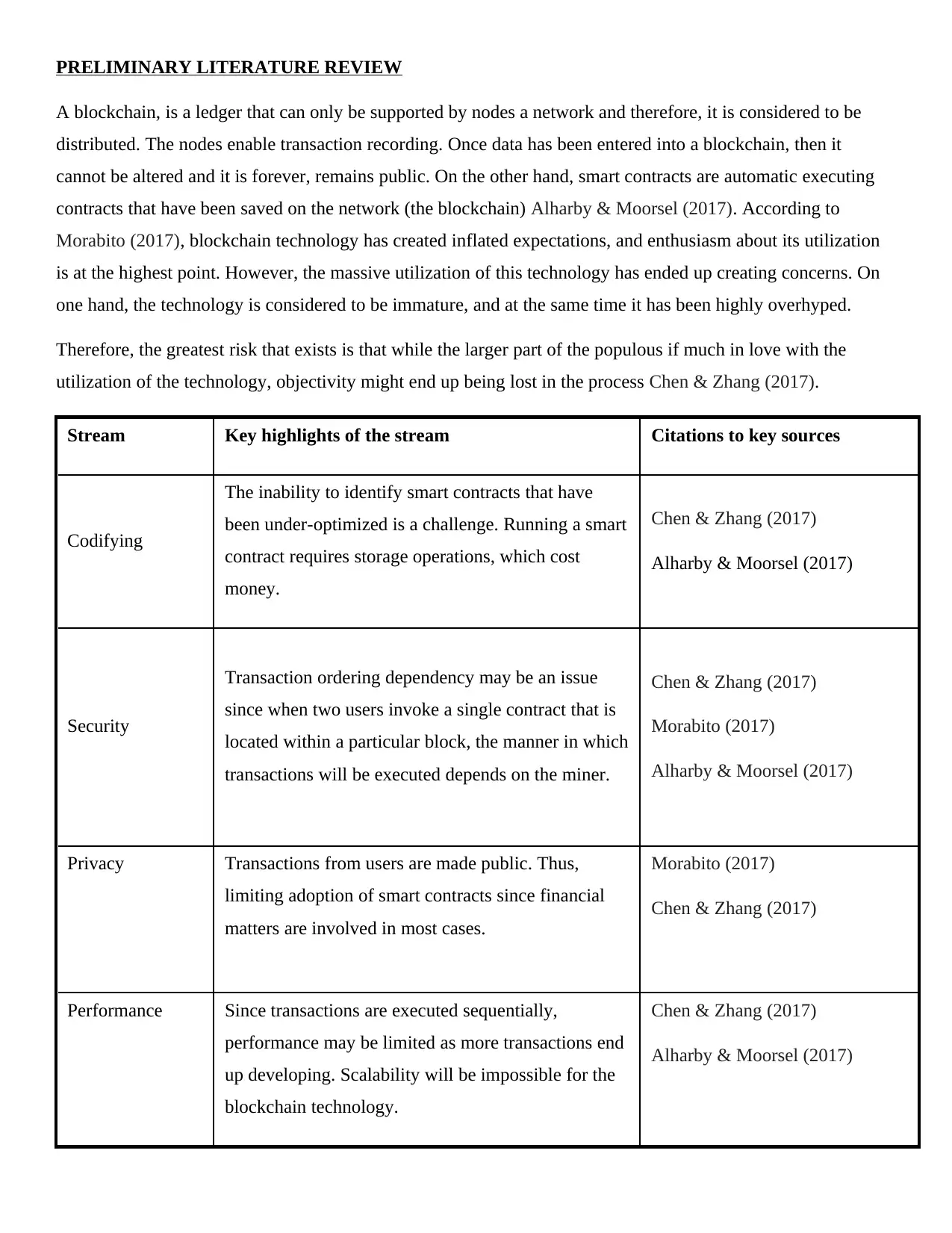
PRELIMINARY LITERATURE REVIEW
A blockchain, is a ledger that can only be supported by nodes a network and therefore, it is considered to be
distributed. The nodes enable transaction recording. Once data has been entered into a blockchain, then it
cannot be altered and it is forever, remains public. On the other hand, smart contracts are automatic executing
contracts that have been saved on the network (the blockchain) Alharby & Moorsel (2017). According to
Morabito (2017), blockchain technology has created inflated expectations, and enthusiasm about its utilization
is at the highest point. However, the massive utilization of this technology has ended up creating concerns. On
one hand, the technology is considered to be immature, and at the same time it has been highly overhyped.
Therefore, the greatest risk that exists is that while the larger part of the populous if much in love with the
utilization of the technology, objectivity might end up being lost in the process Chen & Zhang (2017).
Stream Key highlights of the stream Citations to key sources
Codifying
The inability to identify smart contracts that have
been under-optimized is a challenge. Running a smart
contract requires storage operations, which cost
money.
Chen & Zhang (2017)
Alharby & Moorsel (2017)
Security
Transaction ordering dependency may be an issue
since when two users invoke a single contract that is
located within a particular block, the manner in which
transactions will be executed depends on the miner.
Chen & Zhang (2017)
Morabito (2017)
Alharby & Moorsel (2017)
Privacy Transactions from users are made public. Thus,
limiting adoption of smart contracts since financial
matters are involved in most cases.
Morabito (2017)
Chen & Zhang (2017)
Performance Since transactions are executed sequentially,
performance may be limited as more transactions end
up developing. Scalability will be impossible for the
blockchain technology.
Chen & Zhang (2017)
Alharby & Moorsel (2017)
A blockchain, is a ledger that can only be supported by nodes a network and therefore, it is considered to be
distributed. The nodes enable transaction recording. Once data has been entered into a blockchain, then it
cannot be altered and it is forever, remains public. On the other hand, smart contracts are automatic executing
contracts that have been saved on the network (the blockchain) Alharby & Moorsel (2017). According to
Morabito (2017), blockchain technology has created inflated expectations, and enthusiasm about its utilization
is at the highest point. However, the massive utilization of this technology has ended up creating concerns. On
one hand, the technology is considered to be immature, and at the same time it has been highly overhyped.
Therefore, the greatest risk that exists is that while the larger part of the populous if much in love with the
utilization of the technology, objectivity might end up being lost in the process Chen & Zhang (2017).
Stream Key highlights of the stream Citations to key sources
Codifying
The inability to identify smart contracts that have
been under-optimized is a challenge. Running a smart
contract requires storage operations, which cost
money.
Chen & Zhang (2017)
Alharby & Moorsel (2017)
Security
Transaction ordering dependency may be an issue
since when two users invoke a single contract that is
located within a particular block, the manner in which
transactions will be executed depends on the miner.
Chen & Zhang (2017)
Morabito (2017)
Alharby & Moorsel (2017)
Privacy Transactions from users are made public. Thus,
limiting adoption of smart contracts since financial
matters are involved in most cases.
Morabito (2017)
Chen & Zhang (2017)
Performance Since transactions are executed sequentially,
performance may be limited as more transactions end
up developing. Scalability will be impossible for the
blockchain technology.
Chen & Zhang (2017)
Alharby & Moorsel (2017)
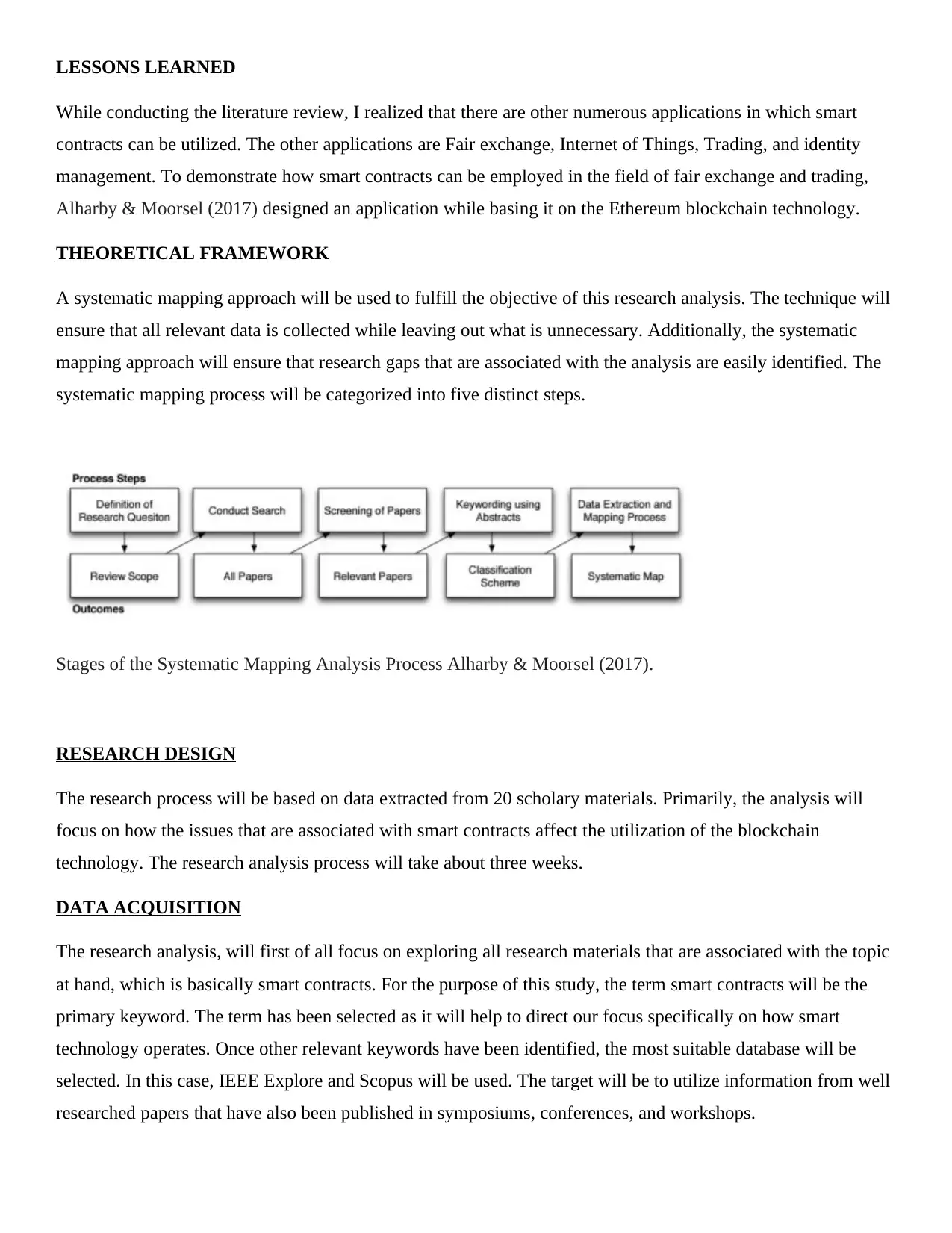
LESSONS LEARNED
While conducting the literature review, I realized that there are other numerous applications in which smart
contracts can be utilized. The other applications are Fair exchange, Internet of Things, Trading, and identity
management. To demonstrate how smart contracts can be employed in the field of fair exchange and trading,
Alharby & Moorsel (2017) designed an application while basing it on the Ethereum blockchain technology.
THEORETICAL FRAMEWORK
A systematic mapping approach will be used to fulfill the objective of this research analysis. The technique will
ensure that all relevant data is collected while leaving out what is unnecessary. Additionally, the systematic
mapping approach will ensure that research gaps that are associated with the analysis are easily identified. The
systematic mapping process will be categorized into five distinct steps.
Stages of the Systematic Mapping Analysis Process Alharby & Moorsel (2017).
RESEARCH DESIGN
The research process will be based on data extracted from 20 scholary materials. Primarily, the analysis will
focus on how the issues that are associated with smart contracts affect the utilization of the blockchain
technology. The research analysis process will take about three weeks.
DATA ACQUISITION
The research analysis, will first of all focus on exploring all research materials that are associated with the topic
at hand, which is basically smart contracts. For the purpose of this study, the term smart contracts will be the
primary keyword. The term has been selected as it will help to direct our focus specifically on how smart
technology operates. Once other relevant keywords have been identified, the most suitable database will be
selected. In this case, IEEE Explore and Scopus will be used. The target will be to utilize information from well
researched papers that have also been published in symposiums, conferences, and workshops.
While conducting the literature review, I realized that there are other numerous applications in which smart
contracts can be utilized. The other applications are Fair exchange, Internet of Things, Trading, and identity
management. To demonstrate how smart contracts can be employed in the field of fair exchange and trading,
Alharby & Moorsel (2017) designed an application while basing it on the Ethereum blockchain technology.
THEORETICAL FRAMEWORK
A systematic mapping approach will be used to fulfill the objective of this research analysis. The technique will
ensure that all relevant data is collected while leaving out what is unnecessary. Additionally, the systematic
mapping approach will ensure that research gaps that are associated with the analysis are easily identified. The
systematic mapping process will be categorized into five distinct steps.
Stages of the Systematic Mapping Analysis Process Alharby & Moorsel (2017).
RESEARCH DESIGN
The research process will be based on data extracted from 20 scholary materials. Primarily, the analysis will
focus on how the issues that are associated with smart contracts affect the utilization of the blockchain
technology. The research analysis process will take about three weeks.
DATA ACQUISITION
The research analysis, will first of all focus on exploring all research materials that are associated with the topic
at hand, which is basically smart contracts. For the purpose of this study, the term smart contracts will be the
primary keyword. The term has been selected as it will help to direct our focus specifically on how smart
technology operates. Once other relevant keywords have been identified, the most suitable database will be
selected. In this case, IEEE Explore and Scopus will be used. The target will be to utilize information from well
researched papers that have also been published in symposiums, conferences, and workshops.
⊘ This is a preview!⊘
Do you want full access?
Subscribe today to unlock all pages.

Trusted by 1+ million students worldwide

REFERENCES
Alharby, M. and van Moorsel, A., 2017. Blockchain-based smart contracts: A systematic mapping study. arXiv
preprint arXiv:1710.06372.
Alharby, M. and van Moorsel, A., 2017. Blockchain-based smart contracts: A systematic mapping study. arXiv
preprint arXiv:1710.06372.
Paraphrase This Document
Need a fresh take? Get an instant paraphrase of this document with our AI Paraphraser

Chen, T., Li, X., Luo, X. and Zhang, X., 2017, February. Under-optimized smart contracts devour your money.
In Software Analysis, Evolution and Reengineering (SANER), 2017 IEEE 24th International Conference
on (pp. 442-446). IEEE.
Morabito, V., 2017. Business Innovation Through Blockchain. Cham: Springer International Publishing.
In Software Analysis, Evolution and Reengineering (SANER), 2017 IEEE 24th International Conference
on (pp. 442-446). IEEE.
Morabito, V., 2017. Business Innovation Through Blockchain. Cham: Springer International Publishing.
1 out of 8
Related Documents
Your All-in-One AI-Powered Toolkit for Academic Success.
+13062052269
info@desklib.com
Available 24*7 on WhatsApp / Email
![[object Object]](/_next/static/media/star-bottom.7253800d.svg)
Unlock your academic potential
Copyright © 2020–2025 A2Z Services. All Rights Reserved. Developed and managed by ZUCOL.





